|
| |
Back to Trainers
A large number of
countries have decided that building a military trainer is their first step on
the road to an indigenous defence industry. Many of these have been
disappointed, either because their product was inferior to existing established
designs from major manufacturers, or because the development costs escalated out
of all proportion to the benefit, or both. The large range of countries in this
list partly reflects this trend, but is perhaps influenced more by the fact that
many air forces are keener to exhibit - or later, sell off - their trainers than
they are their advanced combat aircraft!
| Belgium |
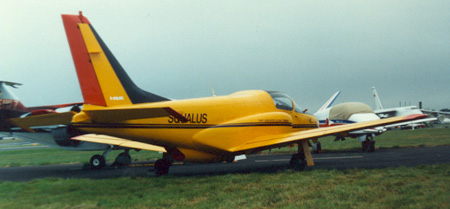 |
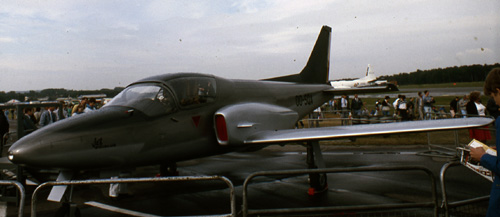 |
|
The Promavia Jet Squalus (Latin for Shark)
was designed by Italian engineer Dr Stelio Frati, and clearly shows
the elegant stylish lines typical of his work. It was designed to
the specification issued by the USAF for their abortive New
Generation Trainer (NGT) contest. It is a two seater, powered by an
Allied Signal TFE109 turbofan of 1,330lb static thrust. This gives
it a typical cruising speed of 320mph and range of 800 miles. It is
30 feet 8 inches long, with a wing span of 29 feet 8 inches. It
first flew in 1987. Only two were built before the NGT contest was
cancelled. The design rights have now been taken over by Phoenix
Aircraft, who have re-engined it (in line with original design
intentions) with an 1,800lb Williams FJ44 and are marketing it as
the Phoenix Fanjet.
Top: Farnborough, September 1988
Lower: Farnborough, September 1986. |
|
Brazil |
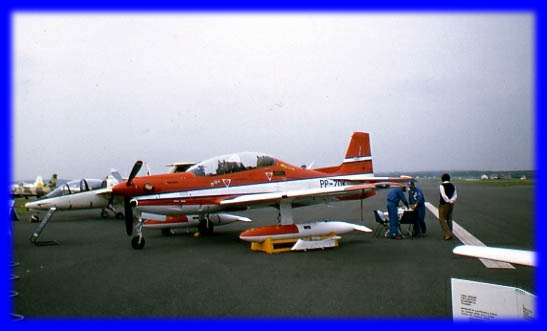 |
|
The Embraer EMB312 Tucano was initially
designed as a trainer for the Brazilian air force, with whom it is
known as the AT27. It first flew in August 1980, and demonstrated
excellent performance. Top speed is 280mph and range 1,145 miles. It
is powered by a single Pratt & Whitney Canada PT6A turboprop of
750shp. It is 9.88m long and has a wing span of 10.97m. Gross weight
is 3,175Kg (7,000lb). The RAF selected
the Tucano, re-engined with a Garrett TPE331 turboprop, as the
replacement for the Jet Provost. RAF aircraft have been built by
Short Brothers (now a division of Bombardier), in Belfast. All told,
several hundred have been built for a wide variety of customers.
This company demonstrator was at Farnborough
in September 1982. |
|
|
The De Havilland Canada DHC1 Chipmunk first
flew in May 1946. It is a delightful handling aircraft, and was
instantly popular; over 1,000 were eventually built, and operated by
several air forces. Power comes from a 145hp De Havilland Gipsy
Major engine. I is a fairly light aircraft (gross weight 2,000lb),
with top speed of 138mph and range of 300 miles. Its main advantage
is its superb handling, which makes it an excellent training
platform. It also has the `distinction' of being the first aircraft
in which David took the controls - as a cadet in the Air Training
Corps in the 1970s! Used by the RAF as
its standard primary trainer from the 1950s, most of the Chipmunks
were sold to private operators from the 1970s onwards. The top
picture shows Chipmunks of the Army's basic fixed wing flight, still
in military service, at Middle Wallop in July 1986. The middle
picture shows a Chipmunk in Canadian air force markings,
barnstorming at Old Warden in Summer 2005. The lower picture shows
an exotically painted Chipmunk at Wellesbourne Mountford in July
2007. |
| Chile |
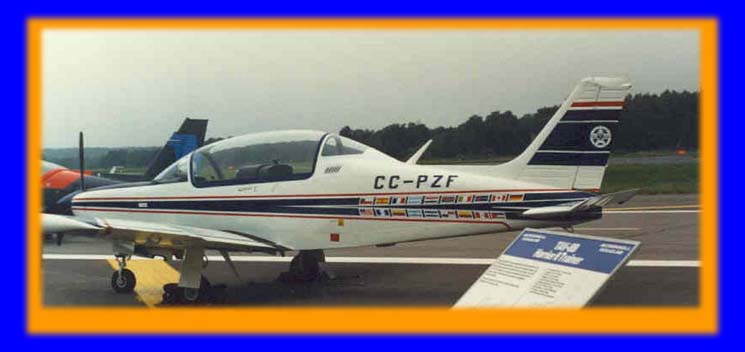 |
|
Chile's Enaer Pillan (Demon) was based on the
PA28-236 version of the Piper Cherokee, with a different cockpit and
upgraded systems. Not surprisingly it was intended mainly for the
Chilean air force, with whom it is known as the T-35. Its 300hp
Lycoming engine gives it a maximum speed of 190mph and range of 750
miles. It first flew in March 1981. Wing span is 8.5 metres and
length a very similar 8.4m. It is operated by Chile, Spain (where it
is known as the E.26), Panama and Paraguay. All told, 145 have been
built. This company demonstrator was at
Farnborough in September 1986. |
|
China |
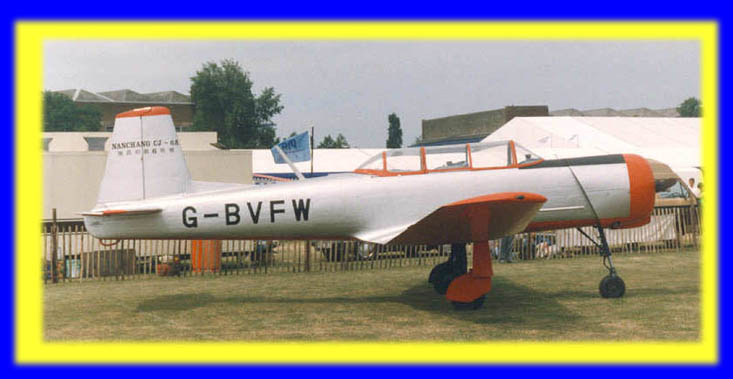 |
|
The Nanchang CJ-6 is essentially a Yakovlev
YAK18, but with a different engine (285hp Quizhou Huosei radial),
undercarriage, tail and canopy. Dimensions are very similar: length
27 feet 51/2
inches, wing span 33 feet 4 inches, and maximum take-off weight
3,080lb. It is fast for a radial engined aircraft, with top speed of
230mph and a range of 450 miles. Since its first flight in 1962,
about 1,800 have been built. Several are now leaving military
service and finding eager buyers in the civil markets, especially in
the USA and Britain, where its superb aerobatic capabilities combine
with low purchase price to make it a very attractive proposition.
The only real downsides are awkward spares availability and
sometimes undocumented history of individual aircraft.
This one was at Cranfield, date unknown. |
|
Czechoslovakia (Czech Republic) |
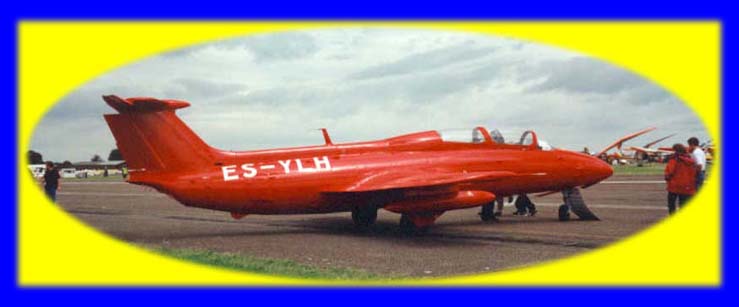 |
|
The Aero L29 Delfin (NATO codename Maya)
first flew in April 1959, and was to become the standard trainer for
all the Warsaw Pact air forces (except Poland, who used their own
TS-11 Iskra) until succeeded by the L-39. Powered by a single
Motorlet M-701 turbojet giving 1,960lb thrust, it has a top speed of
405mph and range of 400 miles. It is quite compact for a jet, being
35 feet 5 inches long with a wing span of 33 feet 9 inches. Gross
weight is 7,230lb. An amazing 3,500 were built.
A few are finding their way to civil operators
in the West, including this Estonian registered example which
visited Cranfield in 1998. |
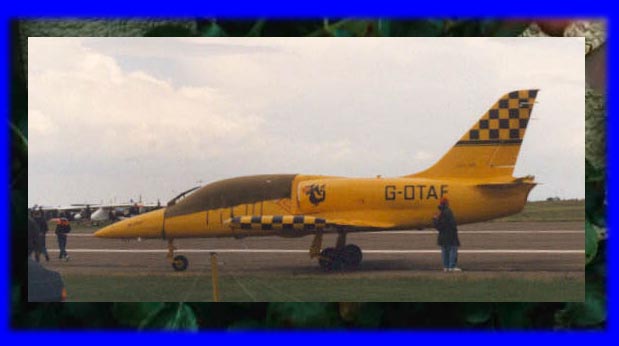 |
The Aero L39 Albatros was the successor to
the L-29 Delfin as the standard jet trainer for the Warsaw Pact air
forces. It bears a passing resemblance to the British Hawk, but
predates it by some time, first flying in November 1968. At 40 feet
5 inches, it is longer than the L-29, though with a shorter 31 foot
wingspan. Powered by a single 3,800lb Walter Titan turbofan, it can
reach 485mph and has a range (with long range fuel tanks) of 1,000
miles. Gross weight is 11,600lb. As with the L-29, it was built in
huge numbers, more than 2,800 having been completed before
production ended. As well as its normal training role, it can carry
a variety of weapons on four underwing hardpoints for use as a
ground attack aircraft. Many are now
flying with civil operators, including this one seen at Cranfield in
1996. |
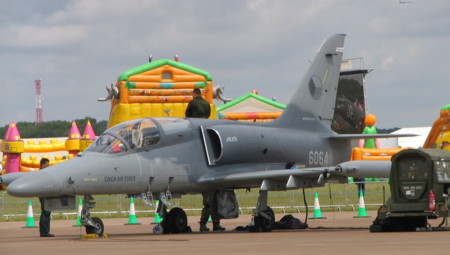 |
The Aero L-159 ALCA is a major update of the
L-39, which first flew in August 1997. It is slightly longer (41
foot 8 inches) thanks to the extra space needed for improved
avionics, the wing span (31' 3") being virtually the same. The more
powerful (6,280lb) Honeywell F124 engine gives it a top speed of
577mph, while gross weight (those extra avionics again, extra
hardpoints, and more fuel) has increased to 17,600lb. Extra fuel
increases the range to over 1,500 miles. Only about 70 of these very
capable aircraft have been built so far, all for the Czech forces.
Czech Air Force, Fairford, July 2007 |
|
Egypt |
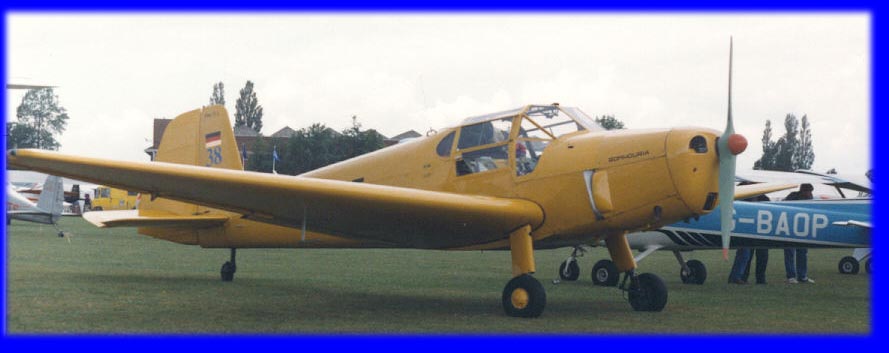 |
|
The Gomhouria was a license-built version of
the 1939 German Bucker Bu181 Bestmann, built in Egypt's Heliopolis
Aircraft Works. Normally powered by a 105hp Hirth engine, it has a
top speed of 135mph and range of 500 miles. It is a typically long
winged design, as were most monoplanes of the era, being 25 feet 6
inches long with a wing span of 34 feet 5 inches. Maximum weight is
1,650lb. Few survive; this rare example
visited Cranfield in 1996. |
|
Finland |
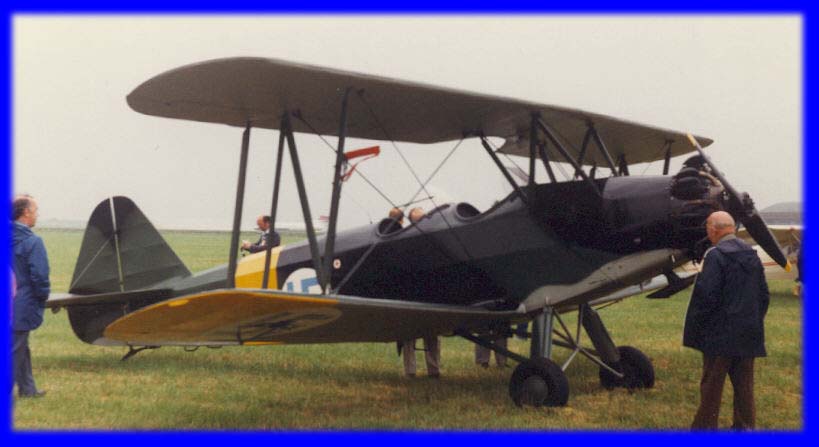 |
|
The Valmet Viima is an elegant biplane
trainer built specifically for the Finnish air force, having its
first flight in 1936. It has a close resemblance to the German
Focke-Wulf Steiglitz. Power is from a 150hp Siemens SH14 radial
engine. Only 24 were built. This rare flying example was based for
many years at High Wycombe, and was used in several films to depict
early aircraft. This picture was taken
at Wroughton in 1988. |
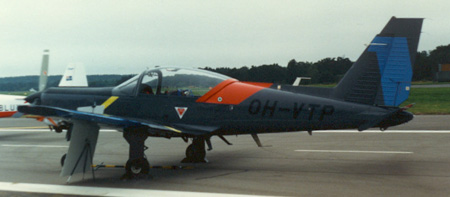 |
Valmet re-entered the trainer market in the
1980s with the L-70 Miltrainer, otherwise known as the Vinka
(Finnish for Blast), which was later developed into the L-90 Redigo.
Looking not unlike the Italian SF-260, it is a three seater, powered
by a 200hp engine, giving it a cruising speed of 125mph over a range
of 500 miles. The L-70 first flew in July 1975. Only about 30 have
been made (not counting L-90s). It is 24 feet 5 inches long with a
wing span of 31 feet 2 inches and maximum weight of 2,750lb.
This demonstrator was at the Farnborough air
show in 1988. |





|